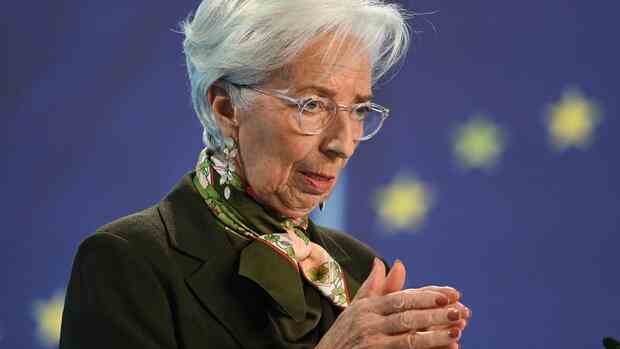The ECB President will meet with her Council colleagues for the next interest rate meeting on March 16th.
(Photo: dpa)
Frankfurt Investors expect the European Central Bank (ECB) and the US Federal Reserve to raise interest rates more than just a few weeks ago. For the USA, a key interest rate of around 5.25 percent at the end of the year is now priced in on the futures market – at the beginning of February it was still around 4.5 percent. The key interest rate is currently in the range of 4.5 to 4.75 percent.
The situation is similar in Europe. There, the deposit interest rate, which is decisive on the financial markets, is 2.5 percent. Banks receive this for excess funds that they hold at the central bank. From the prices on the futures market, an expected level of around 3.75 percent can be derived for the end of the year, after around 3.5 percent previously.
The reason for the changed outlook is the latest statements from leading central bankers and better-than-expected economic data. ECB Director Isabel Schnabel warned on Friday that inflation in the euro area could prove to be more stubborn than the markets are currently pricing in. In addition, the economy reacts more slowly than before to the interest rate hikes. The ECB must therefore “possibly act more vigorously”.
ECB President Christine Lagarde has already signaled a rate hike of half a percentage point for March. The central bank also wants to reassess the further situation at the meeting.
Several institutes have raised their interest rate forecasts this week. The US bank Goldman Sachs raised its estimate for the peak of the deposit rate from 3.25 to 3.5 percent, the Deutsche Bank raised its forecast from 3.5 to 3.75 percent. Deutsche Bank analyst Mark Wall cited the relatively good economic development in Europe and the latest statements by ECB representatives as reasons for the revision.
In the US, too, various data have recently indicated that the economy is doing better than expected, which is also fueling speculation about stronger interest rate hikes.
This was particularly noticeable in the labor market data. More than 500,000 new jobs were created in January. Economists had expected just 200,000. This is further evidence that the US labor market is very tight.
>> Read here: Lagarde sees no wage-price spiral in the euro area
This in turn increases the risk of a wage-price spiral, i.e. a situation in which higher wages and prices reinforce each other. The inflation rate at the beginning of the year also fell less sharply than had been predicted.
Fed officials hint at tighter course
Several Fed officials recently indicated a sharper course. According to Richmond regional Fed chief Thomas Barkin, if inflation stays at levels well above 2 percent, “more needs to be done” may be needed.
Cleveland regional Fed Chair Loretta Mester called a half-percentage-point rate hike in March “quite reasonable.” That would be a larger hike than in early February, when the Fed raised interest rates by a quarter of a point. However, Mester is also considered a particularly prominent advocate of tight monetary policy.
More: Next stop 6 percent – how the Fed is preparing the markets for the next phase of rate hikes


